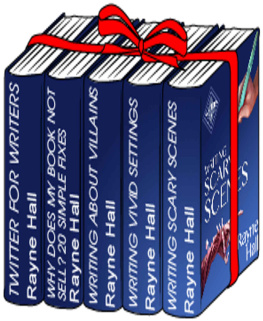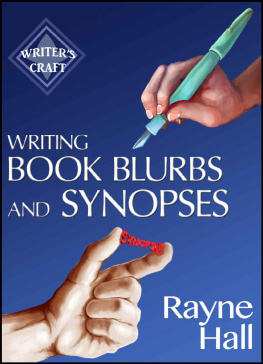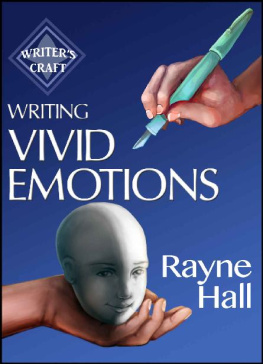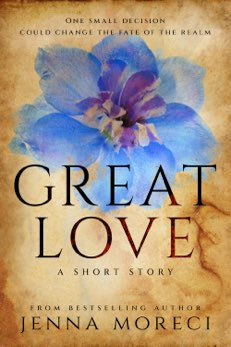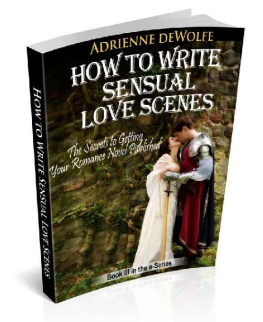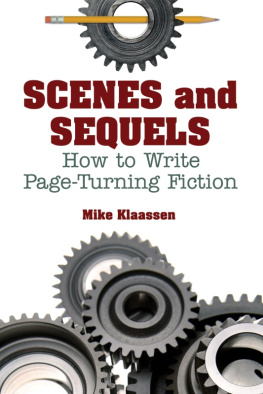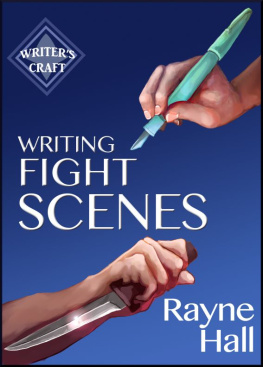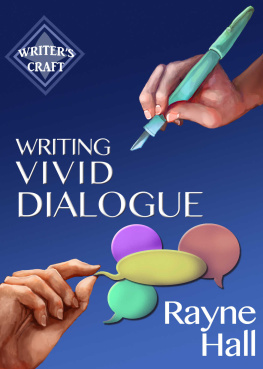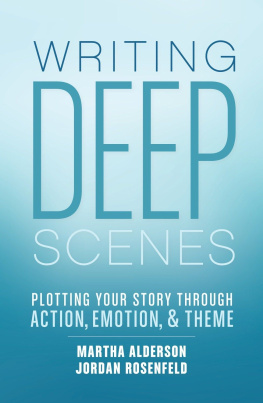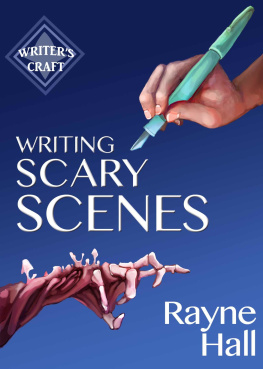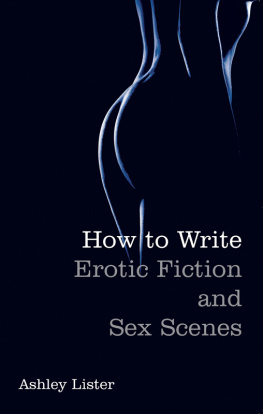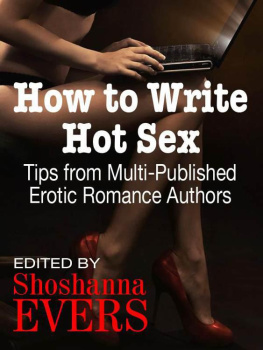TABLE OF CONTENTS
EXCERPT FROM
WRITING VIVID EMOTIONS
WRITING LOVE SCENES
by Rayne Hall and Susanne McCarthy
WRITING LOVE SCENES
by Rayne Hall and Susanne McCarthy
Book cover by Erica Syverson and Manuel Berbin
2018 Rayne Hall
March 2018 Edition
All rights reserved. Do not resell, reproduce or distribute this work in whole or in part without Rayne Halls written permission.
British English.
INTRODUCTION
Do you want to write powerful love scenes which stir the readers emotions?
This book shows you how to create a vivid love scene or improve a bland draft so it touches the readers heart. You will learn the techniques professional authors use to create conflict, depth and intensity, and craft heart-warming and harrowing scenes that stay forever in the readers mind.
We dark fiction author and creator of the Writers Craft series Rayne Hall, and romance author Susanne McCarthy have combined our expertise and will show you how to write love scenes like a pro.
Whether you pen romance novels or need a compelling love scene for a different genre, this book is for you.
Some chapters are useful for all fiction genres, for example, how to write flirtatious dialogue and how to describe a romantic location. Others serve specific plot situations, such as first kiss, characters in disguise, confessing a secret, break-ups and marriage proposals.
In some sections, we provide guidance for specific kinds of fiction, such as how to write gay love scenes or relationships between different species. You decide which topics are relevant for your writing, and select which chapters you want to study.
Depending on how steamy or chaste you want your love scenes, we offer you a menu of topics to choose from: writing graphic sex, implying sex without showing it, creating erotic tension without erotic action, and keeping love scenes chaste. Select the ones that suit your taste and the kind of story you write.
At the end of each chapter, we give you assignments, so you can put what youve learned into practice and take your novel-in-progress forward.
You wont find rules here. Instead of telling you what and how to write, we reveal our professional techniques and show you how to apply them. You choose which of our pieces of advice you want to use in your writing.
We Rayne and Susanne write differently. Thats why Susanne has added suggestions to Raynes chapters, and Rayne to Susannes. The different perspectives will inspire your own creative choices and enhance your individual author voice.
We assume that youve mastered the foundations of the fiction writing craft, and that you know how to write basic dialogue, develop characters and build a plot. If youre a novice just starting out, it may be best to set this book aside for now and start with a beginner-level guide to fiction writing. Our book is for writers who are ready to master specialised skills.
Like all books in the Writers Craft series, this guide focuses in depth on one specific topic: how to write love scenes. It doesnt cover story structure and novel plotting.
We both use British English, so if youre used to American English, some words and spellings may look unfamiliar. To avoid convoluted phrases of the he or she does this to her or him type, we use the female pronoun in some sections and the male in others.
Now lets get started and create the love scenes your novels characters deserve.
Rayne Hall & Susanne McCarthy
Chapter 1
WHAT MAKES A GOOD LOVE SCENE?
Rayne Hall
Two people enjoying each others company in comfortable surroundings, saying I love you and feeling happy with not a cloud on the horizon in real life, thats a wonderful experience. But it makes a boring love scene.
Adding sex doesnt guarantee an exciting scene. Indeed, many great love scenes dont feature intimate action. Love is a feeling, and your job as a writer is to let your readers share in what the story characters feel. How can you achieve that?
SIX CRUCIAL INGREDIENTS
- The scene keeps the characters apart. I can almost hear you saying What?! Surely love scenes are about the couple being close? But if the characters are united in every sense, the scene is static, the love story is over, and the reader is bored. Find a way to keep the characters from being fully united. For example, they may be physically close (holding each other in a tight embrace) but know that they may never meet again. Or perhaps they are with other people, and although they manage to signal their love, they must be careful that nobody else guesses their secret betrothal.
- The scene has conflict. Conflict doesnt mean arguments! Experienced fiction writers know that conflict drives readers to keep reading. A good scene has both inner and outer conflicts. For guidance on how to layer conflicts in a love scene, see the chapter Inner, Outer and Relationship Conflicts.
- The scene takes the relationship in a new direction. Something changes between the two. Perhaps they learn to trust each other more or maybe the opposite happens, and they trust each other less. They may be more confident about a shared future than before or their plans for their life together collapse. They are more committed to each other than before or perhaps one of them withdraws from the commitment.
- The scene takes the whole story in a new direction. Every scene in your book changes the direction of the plot, ideally in ways the reader didnt expect. Twists and turns make the story exciting to read. Love scenes are no exception.
- The scene grabs the reader emotionally. Whether your scene is heart-warming or heart-wrenching, it must do something to the readers heart. The reader needs to feel what the characters feel not just love, but the whole mix of emotions the characters go through, such as desire, despair, yearning, hurt, jealousy, trust, gratitude and hope. For tips on how to create reader emotion, see the chapter How to Stir the Readers Emotions.
- The Point-of-View Character grows as a result of the scene . She will probably be wiser in some way. Perhaps shell be more cautious or more courageous, bolder or calmer. The other lover who is not the PoV probably changes too, although their growth may be less obvious to the reader. (For more about this, see the chapter How to Immerse the Reader: Point-of-View.)
WHAT NOT TO DO
Novice writers tend to write love scenes in which both characters are happy, rejoicing in their love, and enjoying their togetherness, with no problem or conflict. Dont bore your readers.
Dont write a static love scene in which nothing changes. The scene needs to alter the character, the relationship and the direction of the story.
SUSANNES SUGGESTION
A good love story has two characters whom the reader is rooting for because they are attractive (though not necessarily beautiful), likable, perhaps noble. The reader knows they should be together, wants them to be together but something is keeping them apart. That something should be significant, or the book will end up sailing across the room.
Each love scene within the story will be a microcosm of that tension between attraction and conflict. Each scene should nudge the story forward though the balance between attraction and conflict may vary, and sometimes it will seem to take the story backwards if conflict appears to be winning.
Therefore each scene should be carefully placed on the arc of the story to ensure that the progression is meaningful, that it doesnt go round in circles, that it doesnt make irrational leaps or depend on awkward contrivances.
Each scene should increase the tension, until the story reaches its climax, when attraction and conflict explode and hopefully attraction wins (though not always with a Happy-Ever-After if you are not writing for the Romance market.)
Next page



